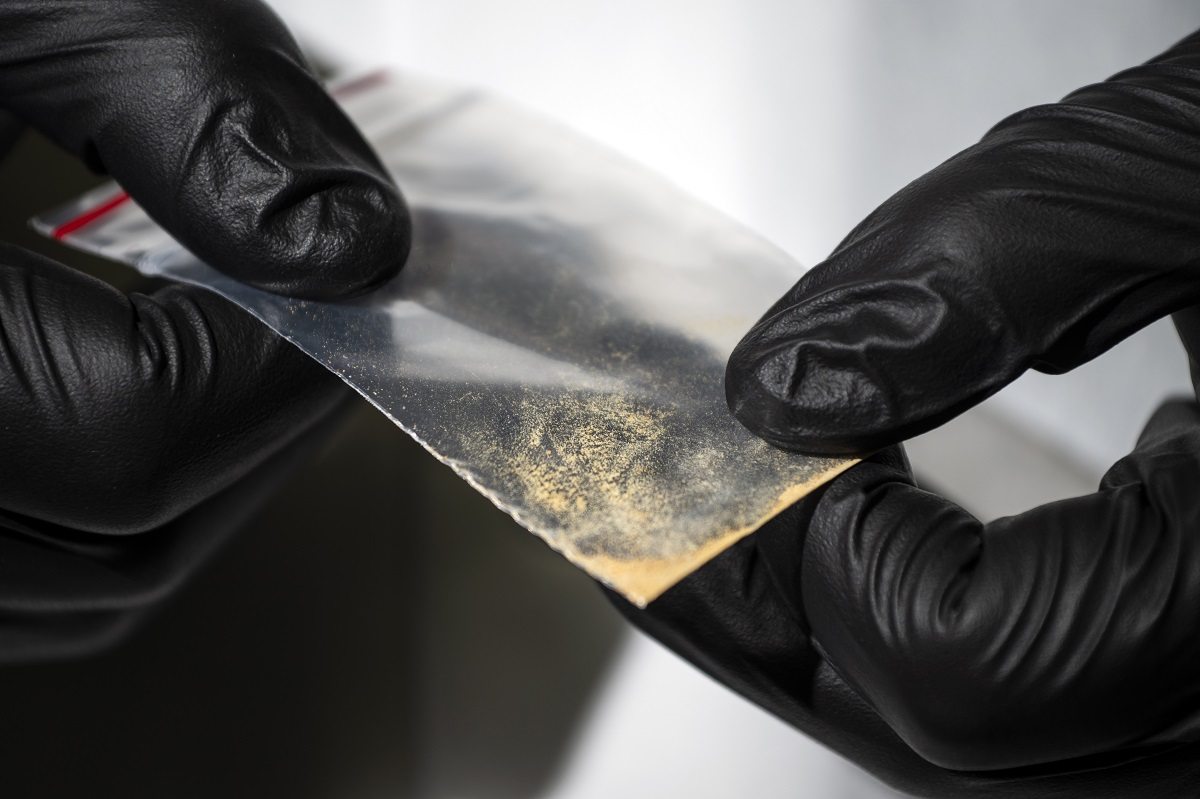
Cathy Sheely, who lives in Kannapolis, N.C., had never heard of nitazenes before the overdose death of her daughter, Samantha Ross.
15:31 JST, December 11, 2023
After years spent addicted to heroin on the streets of North Carolina, Samantha Ross had turned her life around. She marked four years in recovery, got married and traveled last year to Miami Beach to celebrate her 34th birthday.
By then, the cravings had returned.
Ross told her husband she’d gone out and used methamphetamine and crack cocaine, according to a Miami-Dade County medical examiner’s report. That morning, Ross’s husband found her dead of an overdose, slumped in a bed at their Airbnb, two pipes and a baggie with powder residue at her side. Toxicology tests revealed she’d consumed cocaine and fentanyl – plus two other drugs belonging to a class of opioids known as nitazenes. One of those drugs is estimated to be 43 times more potent than fentanyl.
Ross’s mother, Cathy Sheely, had never heard of nitazenes. She doubts her daughter knew she was ingesting them. “We’ve all heard of fentanyl but didn’t know there were these other drugs out there killing people,” Sheely said.
The novel opioids can be many times more powerful than fentanyl and can complicate overdose revivals and addiction treatment. Even as illicit fentanyl manufactured in Mexico remains by far the chief catalyst for overdose deaths in the United States, the increasing presence of nitazenes adds another layer of health concerns as users often have no inkling they are consuming those opioids.
A recently unsealed federal indictment in South Florida opens a rare window into the source of nitazenes: manufacturers in China that officials say sell the drugs online and ship them to dealers in the United States. Prosecutors allege that a Deerfield Beach, Fla., man used WhatsApp and bitcoin to purchase nitazenes to mix with fentanyl or heroin, to stretch out his supplies of opioids and make an “ultra powerful substance.”
“The nitazenes can make [a drug mix] stronger than fentanyl,” said Anthony Salisbury, the special agent in charge of the Homeland Security Investigations field office in South Florida. “As if we needed something stronger than fentanyl.”
The South Florida case from October included indictments against a Chinese chemical sales company and an employee of that company. According to one of the indictments, the Chinese company selling nitazenes used websites, social media accounts and messaging apps to sell chemicals such as protonitazene and metonitazene to customers in the United States, Europe, Asia and South America. As part of the investigation, a U.S. Postal Inspection Service agent posing as a buyer ordered nitazenes from the company, according to the indictment.
It was among the first criminal prosecutions to target an overseas source of nitazenes, Salisbury said.
U.S. federal indictments also targeted Chinese companies allegedly selling precursor chemicals used to make fentanyl. Additionally, charges were brought against a company alleged to have used websites to sell xylazine, an animal tranquilizer, known as “tranq,” that some drug dealers add to fentanyl. The Biden administration has labeled the mix of xylazine and fentanyl – which causes ghastly flesh wounds – as an emerging threat.
Chinese chemical and pharmaceutical companies have played a significant role in the proliferation of illicit synthetic drugs in the past decade. And although Beijing announced in November that it would curb the sale of precursor chemicals used by Mexican organized crime groups to manufacture fentanyl, experts worry that an unintended consequence could be the proliferation of other synthetic drugs such as nitazenes.
A senior Drug Enforcement Administration official, who spoke on the condition of anonymity to discuss the issue candidly, said the agency is monitoring how the illicit drug marketplace may evolve, including the possibility that if “one supply of an opioid were to change that there would potentially be something else that would fill that space.”
Nitazenes were developed by researchers at a Swiss pharmaceutical company in the 1950s as potential painkillers but were never approved for wider use. Although they are considered opioids, the chemical structure of nitazenes differs from fentanyl and related compounds. They began appearing in the United States about 2019, after China – under pressure from the Trump administration – restricted fentanyl-related substances, which are listed as controlled substances in the United States.
Experts say shipments of nitazenes from China have ebbed and flowed as the DEA has placed at least 10 versions of nitazenes on a list of temporarily controlled substances, in a category reserved for those with a high potential for abuse and with no accepted medical use. The DEA plans to restrict two more. The senior DEA official noted that federal law allows authorities to go after traffickers dealing in nitazenes that are not controlled substances, as long as they are chemically similar.
Different versions of nitazenes have appeared in Chicago, Tennessee and West Virginia, said Alex J. Krotulski, the associate director of toxicology and chemistry services at the Center for Forensic Science Research & Education, a nonprofit entity that runs an early warning program researching novel drugs.
The center announced in December that a nitazene called N-Desethyl etonitazene had been detected for the first time in two samples, one from the coroner’s office in Boulder, Colo. It is 10 times stronger than fentanyl. Another of the latest nitazenes to emerge in the past year – known as N-Pyrrolidino protonitazene – is estimated to be 25 times more potent than fentanyl.


Top: Alex J. Krotulski, an associate director at the Center for Forensic Science Research & Education, holds a sample of nitazene powder. Some variants of the drug are stronger than fentanyl.
Bottom: Alex J. Krotulski prepares nitazene samples for analysis.
Krotulski said that between 10 and 15 types of nitazenes exist on the illicit market.
“This is all new, labs in China creating these drugs. They know how to create them because the blueprints are out there [online], but they’re creating new modifications, new drugs that sort of skirt around these national and international laws but still retain those opioid-like effects that people are interested in,” Krotulski said.
Health officials in multiple countries have issued warnings about nitazenes in recent years. British toxicologists said they have detected nitazenes in the blood of more than a dozen people, typically heroin or cocaine users, who died in the London and Suffolk area since July. The opioids have also been linked to recent overdose deaths in Northern Ireland. In Edmonton, Canada, law enforcement officers last year said they seized 10.5 kilograms of isotonitazene during a raid of a drug “super lab,” the largest seizure of that drug in the country’s history.
In D.C., nitazenes were first identified on used syringes in November 2021, prompting the District’s forensic lab to issue an alert to public health partners.
Naloxone, the commonly used overdose reversal drug, can revive nitazene users. But nitazenes may complicate rescue efforts if users or medical personnel do not know the drugs have been consumed. In a study published in August, researchers found that a small group of emergency room patients who had taken nitazenes needed more naloxone than people overdosing on fentanyl. Two patients who ingested a compound known as metonitazene suffered heart attacks. One died, according to the study in JAMA Network Open.
“The concerns about nitazenes being more potent than fentanyl were confirmed by the study,” said Alex F. Manini, a study co-author and a professor of emergency medicine at the Icahn School of Medicine at Mount Sinai in New York.
With the increasing unpredictability of the makeup of the nation’s illicit narcotics supply, users may unwittingly become hooked on nitazenes that were mixed into drugs without their knowledge.
That volatility means users cannot always get the same drug configurations and risk going into withdrawal if they do not, said Jon E. Zibbell, a senior scientist at the nonprofit research institute RTI International. “And then, when [users] enter treatment, providers have no idea what to prescribe patients experiencing withdrawal symptoms,” he said.
It isn’t easy to gauge the prevalence of nitazenes in the drug supply because many police and medical examiner labs do not routinely test for them.
NMS Labs, which partners with the Center for Forensic Science Research & Education and conducts toxicology tests for medical examiners and coroners, has identified at least 749 nitazene-involved deaths since 2019, almost certainly an undercount, Krotulski said. Tennessee health officials published data showing a total of 52 nitazene-related deaths in 2020 and 2021. None were recorded in 2019.
In Florida’s Miami-Dade County, medical examiner toxicologists last year began testing for some nitazene compounds and are adding more to their routine screenings.
In one case, according to a medical examiner’s report, a 52-year-old former soldier with a history of drug use and mental illness was found dead in his family’s Miami Beach home last fall. Tests revealed he died of the effects of a staggering array of drugs, including fentanyl, methamphetamine, cocaine, the anti-anxiety drug clonazepam – and butonitazene, a nitazene that is slightly less potent than fentanyl but still more powerful than heroin. The following month, the man’s older brother – depressed by his sibling’s passing – died of an overdose that included fentanyl and butonitazene, according to medical examiner records. Their mother could not be reached for comment.
Luke Knox, a 22-year-old Florida International University football player, was discovered unconscious in his Miami dorm room last year. Doctors could not save his life. Toxicology tests performed by the county medical examiner showed Knox died of an accidental overdose of drugs including bromazolam (an illegal benzodiazepine); mitragynine, the compound found in the herbal substance kratom; and protonitazene, which experts estimate is four times as potent as fentanyl. The toxicology test results were in public records.
Knox is the brother of Buffalo Bills football player Dawson Knox. Luke’s death received widespread publicity, although the cause had not been previously disclosed. His family, contacted through Dawson Knox’s agent, declined to comment.
As for Ross, the 34-year-old from Mint Hill, N.C., her life had been marked by tumult. As a child, her older brother died in a car accident. She began drinking heavily as a teen. Later, she turned to heroin and went to prison for two years on drug-related charges, said Sheely, her mother. After prison, she found recovery by going to a clinic for methadone, the prescription drug that treats opioid use disorder. She got married in Las Vegas several months before her death – her wedding dress still hangs in her husband’s closet, Sheely said.
Shortly before her trip to Miami Beach, Ross’s opioid cravings had returned because her methadone doses were so low, Sheely said. Along with cocaine and meth, toxicology tests showed, Ross had ingested metonitazene and N-Pyrrolidino etonitazene, the latter of which is 43 times more potent than fentanyl, experts say.
“She had overcome so much. For this to come out of nowhere – my youngest son figures he’s next because I’ve lost two other children,” Sheely said. “It just broke all of our hearts.”

Samantha Ross, her picture held by her mother, dealt with addiction for years.
"News Services" POPULAR ARTICLE
-

American Playwright Jeremy O. Harris Arrested in Japan on Alleged Drug Smuggling
-

Japan’s Nikkei Stock Average as JGB Yields, Yen Rise on Rate-Hike Bets
-

Japan’s Nikkei Stock Average Licks Wounds after Selloff Sparked by BOJ Hike Bets (UPDATE 1)
-

Japanese Bond Yields Zoom, Stocks Slide as Rate Hike Looms
-

Japan’s Nikkei Stock Average Buoyed by Stable Yen; SoftBank’s Slide Caps Gains (UPDATE 1)
JN ACCESS RANKING
-

Keidanren Chairman Yoshinobu Tsutsui Visits Kashiwazaki-Kariwa Nuclear Power Plant; Inspects New Emergency Safety System
-

Imports of Rare Earths from China Facing Delays, May Be Caused by Deterioration of Japan-China Relations
-

University of Tokyo Professor Discusses Japanese Economic Security in Interview Ahead of Forum
-

Japan Pulls out of Vietnam Nuclear Project, Complicating Hanoi’s Power Plans
-

Govt Aims to Expand NISA Program Lineup, Abolish Age Restriction

























